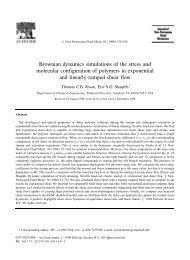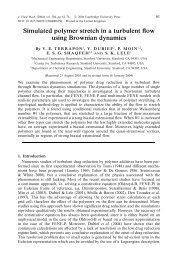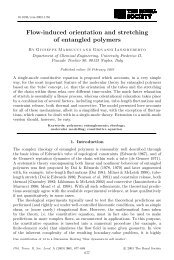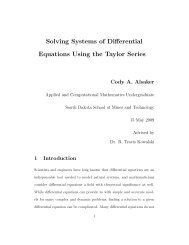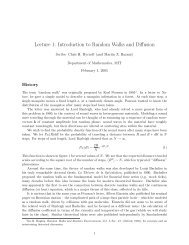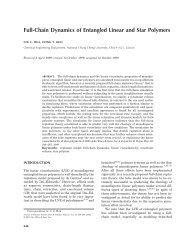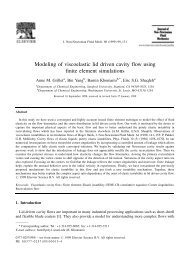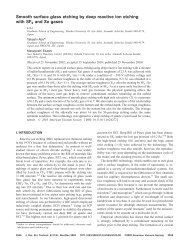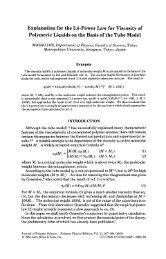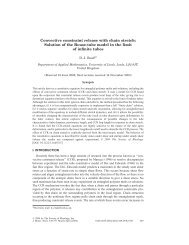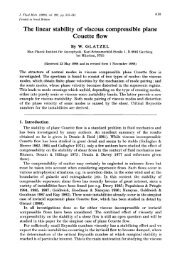A numerical study of the rheological properties of suspensions of ...
A numerical study of the rheological properties of suspensions of ...
A numerical study of the rheological properties of suspensions of ...
Create successful ePaper yourself
Turn your PDF publications into a flip-book with our unique Google optimized e-Paper software.
178 M. B. Mackaplow and E. S. G. Shaqfeh<strong>of</strong> fibres with aspect ratios <strong>of</strong> 33 and 51, respectively. Various <strong>the</strong>oretical predictionsare also shown. These <strong>the</strong>ories make use <strong>of</strong> <strong>the</strong> fact that for an isotropic suspension(pip,) = &,/3 and (PlPJPkPI) = (6&I + &kdJI + ddjk) /15, where we have temporarilyswitched from Gibbs to indicia1 notation. For <strong>the</strong> semi-dilute <strong>the</strong>ory <strong>of</strong> Shaqfeh &Fredrickson (1990), we have used C” = -0.6634. This is <strong>the</strong> <strong>the</strong>oretically predictedvalue listed in $4 for <strong>suspensions</strong> <strong>of</strong> isotropically oriented cylinders.Overall, we see excellent agreement between <strong>the</strong> simulations and experiments. Thisimplies that our simulations are capturing <strong>the</strong> important physics <strong>of</strong> <strong>the</strong> system andthat <strong>the</strong> effects <strong>of</strong> streamline curvature and <strong>the</strong> no-slip condition on <strong>the</strong> outer wallare small. The semi-dilute <strong>the</strong>ory <strong>of</strong> Shaqfeh & Fredrickson (1990) qualitativelyagrees with <strong>the</strong> simulations and experiments while quantitatively underestimatingshear viscosities by about 10%. The semi-dilute <strong>the</strong>ory <strong>of</strong> Dinh & Armstrong (1984)qualitatively disagrees with <strong>the</strong>se results and quantitatively greatly overestimates <strong>the</strong>shear viscosities.Only for <strong>the</strong> most concentrated <strong>suspensions</strong> in figure 8(a), corresponding to fibreswith an aspect ratio <strong>of</strong> 33 and n13 2 9, is <strong>the</strong> agreement between experimentand simulation poor. By definition, in <strong>the</strong> semi-dilute concentration regime, <strong>the</strong>average closest approach distance between any two fibres is much greater than <strong>the</strong>characteristic fibre width. Using <strong>the</strong> results <strong>of</strong> Doi & Edwards (1989) for isotropic<strong>suspensions</strong>, this corresponds to a concentration restriction <strong>of</strong> A/(27cn13) >> O( 1).However, <strong>of</strong> <strong>the</strong> different <strong>suspensions</strong> simulated in figure 8, those corresponding to<strong>the</strong> aforementioned subset have <strong>the</strong> smallest values <strong>of</strong> A/(27cn13), A/(27cn13) < 0.7.This demonstrates that <strong>the</strong> suspension concentrations are well beyond <strong>the</strong> semi-diluteregime. Thus, <strong>the</strong>re are close fibre-fibre interactions which are not captured byour slender-body <strong>the</strong>ory approximation and <strong>the</strong>refore we underestimate <strong>the</strong> effectiveviscosity. This may have been anticipated considering that <strong>the</strong> error involved inslender-body <strong>the</strong>ory in approximating fibre-fibre interactions, as shown by (5), is nolonger negligible when <strong>the</strong>re are many close fibre-fibre interactions.Claeys & Brady (1993) have used Stokesian dynamics simulations to determine <strong>the</strong>shear viscosity <strong>of</strong> suspension <strong>of</strong> spheroidal particles with an aspect ratio <strong>of</strong> 50. Foreach <strong>of</strong> <strong>the</strong>ir published simulation results, holding n13 fixed, we have extrapolatedto results for <strong>suspensions</strong> <strong>of</strong> spheroids with an aspect ratio <strong>of</strong> 51. We do this in amanner similar to <strong>the</strong> cylinder-spheroid conversion discussed earlier (although thisaffects <strong>the</strong> results by less than 1’%0). This allows us to directly compare <strong>the</strong>ir results to<strong>the</strong> predictions <strong>of</strong> our simulations for spheroids with aspect ratios <strong>of</strong> 51. In figure 9we have plotted S$) as predicted by both our simulations, Stokesian dynamics, and0 0( ‘p’><strong>the</strong> dilute <strong>the</strong>ory. From (3) we see thatis <strong>the</strong> average contribution <strong>of</strong> a particleto <strong>the</strong> suspension shear viscosity. Thus, changes in S,, as a function <strong>of</strong> suspensionvolume fraction are a direct measure <strong>of</strong> <strong>the</strong> effect <strong>of</strong> fibre-fibre interactions.In figure 9 we see that our simulations show increasing positive deviation from <strong>the</strong>dilute <strong>the</strong>ory with increasing suspension concentration, while <strong>the</strong> Stokesian dynamicssimulations show no such trend. Although it is difficult to draw firm conclusionsowing to <strong>the</strong> scatter <strong>of</strong> <strong>the</strong> data and <strong>the</strong> limited concentration range investigated by<strong>the</strong> Stokesian dynamics simulation data, it appears that over <strong>the</strong> concentration rangeinvestigated Stokesian dynamics fails to capture <strong>the</strong> effect <strong>of</strong> fibre-fibre interactions.For similar values <strong>of</strong> n13, but with particles <strong>of</strong> aspect ratio 20 or less, Stokesiandynamics simulations do capture <strong>the</strong> effect <strong>of</strong> fibre-fibre interactions, apparently withincreasing ability as fibre aspect ratio decreases. A probable cause for this is that



